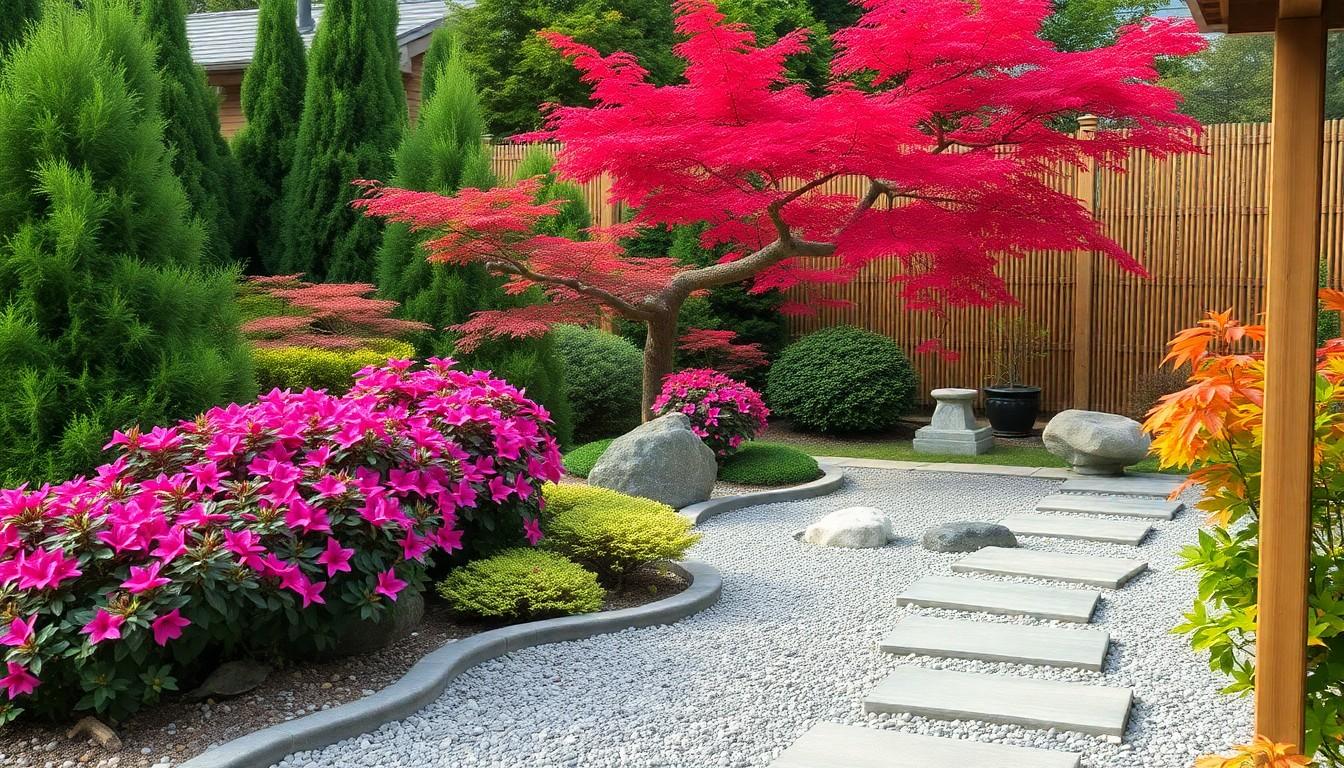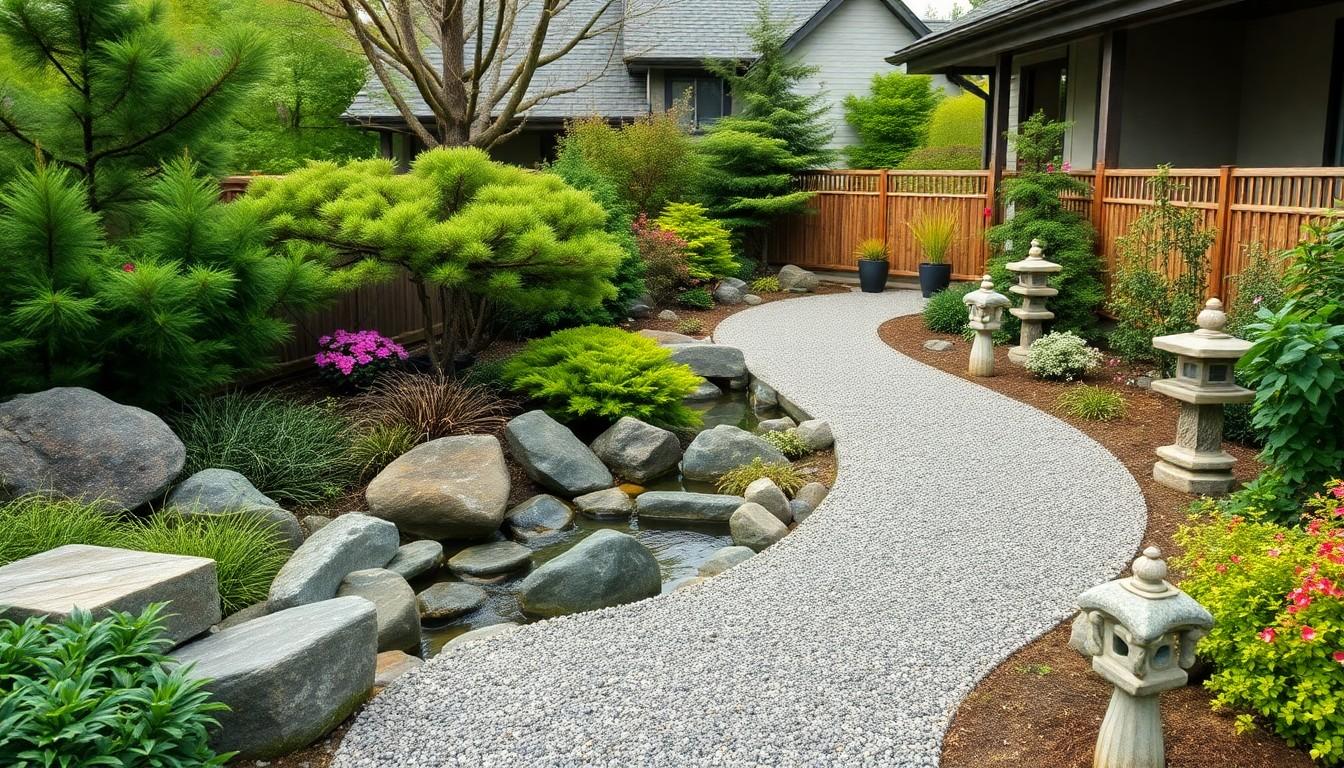Imagine stepping into your front yard and being greeted by a serene oasis that requires minimal upkeep. A low-maintenance Japanese garden design offers just that—a beautiful escape that lets nature do the heavy lifting while you sip your tea and contemplate life’s mysteries. Who wouldn’t want a slice of tranquility right outside their door?
Front Yard Landscaping Low Maintenance Japanese Garden Design
Japanese garden design focuses on creating peaceful and harmonious landscapes. Key elements often include rocks, water features, and plant selections thoughtfully arranged to evoke tranquility. Natural materials like bamboo and stones play a significant role in promoting an organic feel.
A traditional structure often incorporates asymmetry, encouraging balance without strict symmetry. Creating a sense of perspective enhances visual interest, often using paths that lead the eye deeper into the garden. Plants selected for their seasonal interest contribute to the garden’s overall beauty throughout the year.
Common plant types include evergreens, azaleas, and maples, offering color and texture variations. Gravel or sand often symbolizes water in Zen gardens, complementing the aesthetic. Minimalist features such as stepping stones and lanterns may direct movement and encourage contemplation.
Ultimately, functionality and simplicity guide Japanese garden design. Thoughtful placement of elements creates spaces for relaxation and mindfulness. Low-maintenance gardening techniques ensure the beauty remains over time with less effort. Elements such as drought-resistant plants or ground covers instead of grass can significantly reduce upkeep.
Incorporating local climate considerations will enhance sustainability. When executed with care, the result results in a garden that acts as a serene retreat, a space promoting reflection, and nurturing well-being.
Key Elements Of Low Maintenance Design
Low maintenance Japanese garden designs focus on simplicity and functionality. Essential components contribute to a serene environment while minimizing upkeep.
Choosing The Right Plants
Select plants that thrive in the local climate. Evergreens serve as a reliable backbone, providing year-round greenery. Azaleas offer stunning blooms in spring, adding seasonal color. Maples bring striking foliage that changes with the seasons. Consider incorporating native species, which require less water and care. Grouping plants by height and texture enhances visual interest while simplifying maintenance. Utilize ground cover plants to fill empty spaces, reducing the need for weeding. Overall, choosing the right plants enhances beauty without demanding significant effort.
Incorporating Hardscapes
Integrate hardscapes to create structure and reduce maintenance needs. Gravel pathways provide functional walkways while allowing for easy drainage. Stone patios offer durable spaces for relaxation and contemplation. Consider adding decorative rocks for aesthetic appeal and to limit weed growth. Bamboo fences create privacy while blending seamlessly with nature. Use minimalistic elements like stone lanterns for a traditional touch. Focusing on hardscapes simplifies upkeep and balances the garden’s natural elements. Thoughtful integration of these features establishes a cohesive and enduring landscape.
Benefits Of Front Yard Landscaping
Low-maintenance Japanese garden design offers numerous benefits, enhancing outdoor spaces with little effort. These gardens create inviting environments that impress visitors and contribute to overall property value.
Enhancing Curb Appeal
Beautifully designed front yards attract attention and elevate residential aesthetics. Eye-catching features like strategically placed rocks and colorful plant life create a harmonious landscape. Incorporating elements such as bamboo fences or stone paths provides structure and visual interest. Seasonal blooms from azaleas and maples enhance appeal throughout the year. Unique layouts draw the eye, encouraging exploration of the garden. This thoughtful arrangement improves not only the home’s image but also its market value.
Promoting Relaxation
Tranquil gardens foster a sense of peace and well-being. Minimalist design elements, like gravel and water features, evoke serenity and mindfulness. Careful plant selection contributes to a soothing atmosphere, allowing individuals to unwind outdoors. Calm sounds from water elements encourage meditation and reflection. Spaces designed for contemplation promote mental clarity and relaxation. Subtle lighting from lanterns enhances evening enjoyment while maintaining the peaceful ambiance. This serene retreat nurtures personal well-being and helps individuals escape everyday stresses.
Designing Your Low Maintenance Japanese Garden
Designing a low-maintenance Japanese garden requires careful consideration of space and elements. Prioritize simplicity while ensuring a tranquil environment.
Planning The Layout
A thoughtful layout enhances the garden’s harmony and flow. Start by dividing the space into distinct zones for plants, rocks, pathways, and water features. Use curves instead of straight lines to mimic nature’s organic forms. Placement of focal points, like a stone lantern or a koi pond, draws the eye and invites exploration. Routes should connect these elements, guiding visitors through the serene landscape. Position plants according to height and texture, ensuring a visually appealing arrangement. This approach simplifies maintenance while providing year-round interest.
Selecting Soil And Mulch
Choosing appropriate soil and mulch supports healthy plant growth with minimal effort. Begin by testing soil composition to determine necessary amendments. Well-draining soil enhances root health, promoting robust plants. Incorporate organic mulch, such as wood chips or gravel, to suppress weeds and retain moisture. Opt for mulch that complements the garden’s natural aesthetic. Regularly check mulch depth to maintain effectiveness and prevent soil erosion. Selecting quality materials creates a thriving environment for plants to flourish and reduces maintenance tasks.
A low-maintenance Japanese garden design transforms front yards into serene havens with minimal effort. By prioritizing simplicity and functionality, individuals can create a beautiful outdoor space that promotes relaxation and mindfulness. Thoughtful plant selection and strategic use of hardscapes not only enhance visual appeal but also reduce upkeep.
Incorporating elements like rocks, water features, and carefully arranged pathways fosters a harmonious atmosphere. These gardens not only elevate property aesthetics but also contribute to personal well-being. With the right design choices, anyone can enjoy the tranquility of a Japanese garden, making it a perfect retreat from the hustle and bustle of everyday life.


